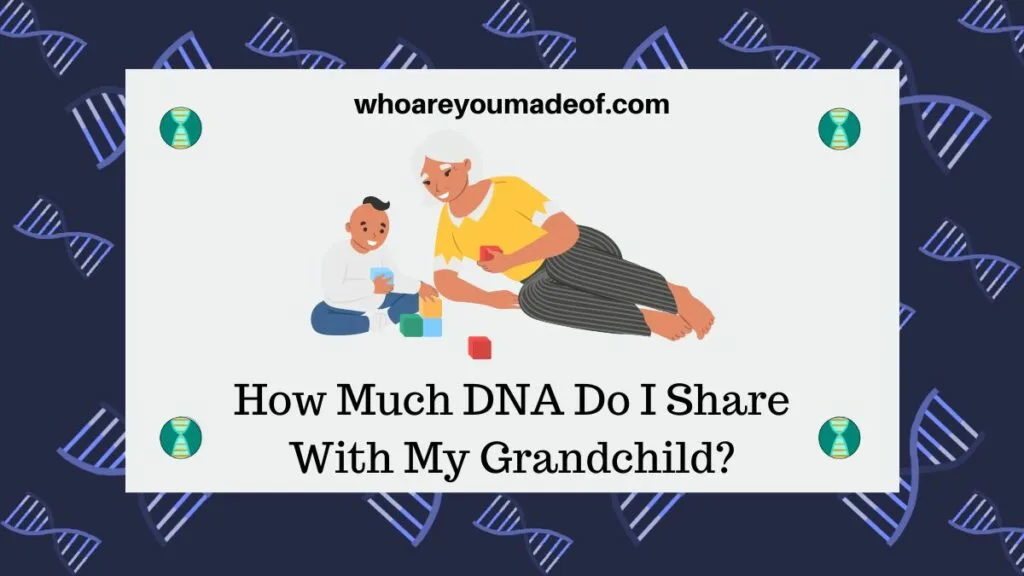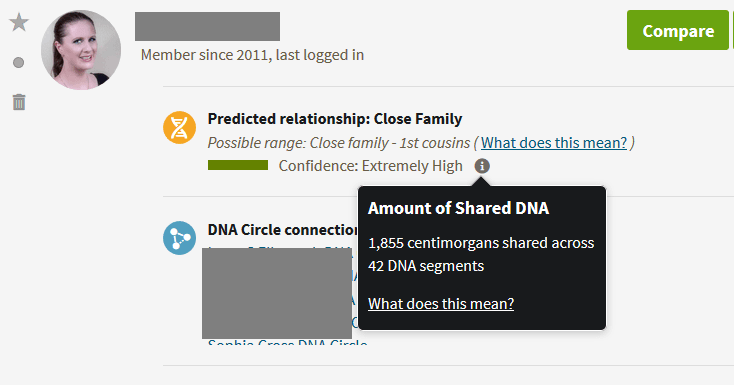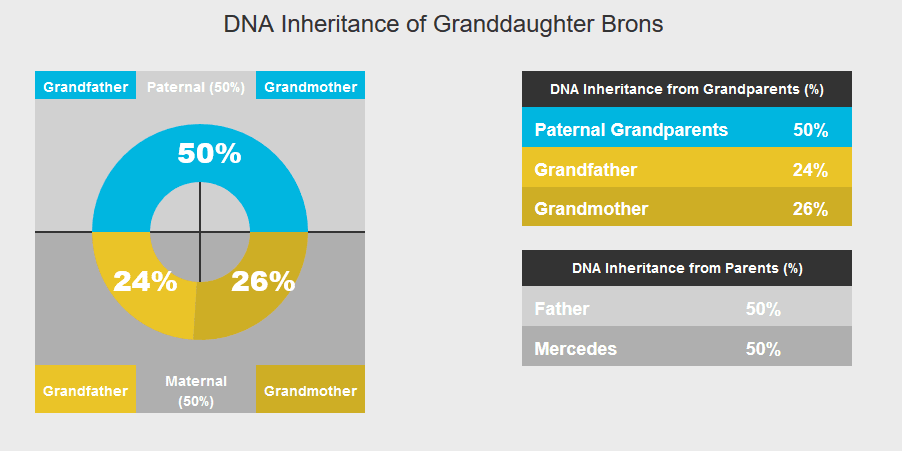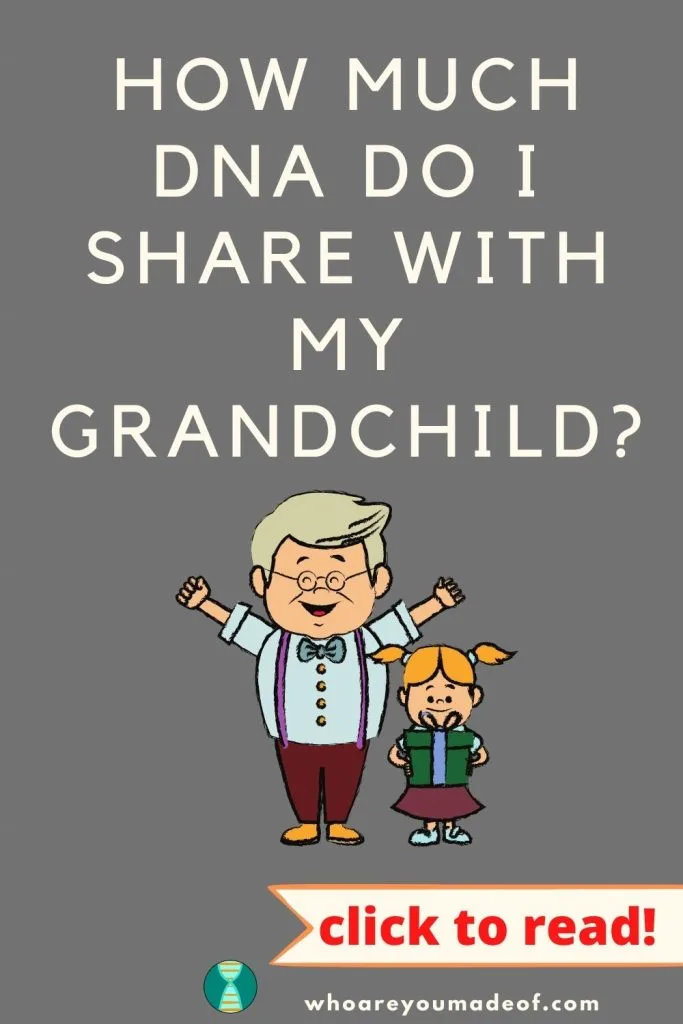Are you wondering how much DNA you would share with a grandchild? Is it a set amount, or could it vary? What's the percentage of DNA that we share with our grandchildren?
Do grandchildren always show up on DNA tests? How much of our ethnicity regions should they share with us? I'll answer all of these questions - and more - in this post.

With the growing popularity of DNA tests like Ancestry DNA and 23andMe, the chance that we will have several generations of DNA matches on our list grows.
For example, in my family, my grandmother, parents, myself, and two of my children have taken DNA tests. That's four continuous generations of DNA testers on the same line of a family.
Ancestry DNA now has more than 23 million users, and when you combine that with the users of the other DNA testing sites, this means a lot of potential DNA matches for all of us.
Many of us will eventually have children, nieces and nephews, great-grandchildren, uncles, aunts, and parents - and many more relatives too numerous to mention - on our DNA match list.
Now, let's talk about grandchildren DNA matches, shall we? It's what we all want to learn about.
How much DNA do you share with your grandchild?
A grandchild, whether a granddaughter or a grandson, will generally share between 1300-2300 centimorgans with either of their grandparents. Expressed as a percentage, grandparents will between 18-32% of their DNA with the offspring of their children, with the average being about 25%.

Why is there a range of shared DNA between grandparents and grandchildren? This is seen in all grandparent/grandchild relationships.
In fact, one grandparent will share different amounts of DNA with all of their grandchildren, even children descended from the same child of the grandparent.
Does it seem odd that if a parent and child share a fairly exact 50% that there could be such a range of shared DNA seen between grandparents and grandchildren?
The reason behind this is due to the way that DNA is passed down from parent to child. When your child passed down his or her DNA to your grandchild, 50% of their DNA was randomly selected to give to the grandchild.
Since your child, the parent of your grandchild, shares an equal amount of DNA with both you and their other parent, some - yet not all - DNA from each of you (the grandparents) was passed down to the next generation.
Does a grandchild share the same DNA with all grandparents?
As you might have guessed, since a child inherits 50% of their parent's DNA and the DNA is randomly selected, sometimes the grandchild shares slightly more DNA with one grandparent than the other.
It will always fall around the range that I mentioned above, however.
As you can see in the image below, my daughter doesn't share the same amount of DNA with my mother as she does with my father. She shares 26% of her DNA with my mother (her grandmother), and 24% of her DNA with my father (her grandfather).

Will a grandchild always show as a DNA match?
Our grandchildren will always show up as DNA matches on DNA results. Since our grandchildren are directly descended from our children and only two generations removed from us, there is no way that a grandchild would not match us genetically.
Barring an error in testing (exceptionally rare), it is statistically and scientifically impossible for a grandchild not to match a grandparent. All grandchildren will share significant levels of DNA with their grandparents.
The exact category that a grandchild gets placed in on a DNA match list will depend on the company that you test with. Each DNA testing company has different categories for DNA matches and slightly different methods for estimating how DNA matches might be related to each other.
Most people will find that their grandchildren show up in the "Close Family" group on Ancestry (though there is a chance that high sharing grandparents/grandchildren will show up in the immediate family category, and low sharing might show up in the first cousin category).
DNA testing companies make a guess at the predicted relationship with our DNA matches, and it is up to us to figure out the exact relationship.
How much of a grandparent's ethnicity regions will a grandchild share?
Even though the average amount of DNA passed down from a grandparent to a grandchild averages about 25%, there are a few reasons that the ethnicity regions that show up in our grandchild's ethnicity estimate might not seem "right" compared to our own estimates.
As you know, the amount of DNA shared between grandparents and grandchildren can range from about 18-32%. The DNA that grandchildren inherit from their grandparents is DNA used to estimate the grandchild's ethnicity regions, as well as determine genetic connections to DNA matches.
This means that a grandchild might inherit more of one grandparent's ethnicity regions, leaving behind some of those that belonged to the other grandparent. Additionally, the grandchild might inherit only parts of ethnicity regions of both grandparent.s
Because the 18-32% of the DNA that a grandchild inherits from a grandparent was randomly selected from the 50% of the randomly selected DNA that the child of the grandparent inherited, it's possible for entire ethnicities to not get passed down from grandparent to grandchild.
Imagine a scenario where a grandparent is 35% Irish and 65% French. This grandparent has a child and passes down 50% of their DNA to their offspring.
It's randomly selected DNA, but since the grandparent has more French than Irish, there is a good chance that the child will get a good deal more French than Irish.
It's possible for the child to get almost no Irish than French, and it's also possible to pass down all of the Irish and only 15% French (though less probable).
To move our scenario along, let's say that the child of the grandparent inherited 20% Irish and 30% French. The other parent of the child was 50% Native American, so now we know that ONE of the parents of the grandchild is 50% Native American, 20% Irish, and 30% French.
When the parent has a child, they will pass down a randomly chosen selection of DNA to their child (the grandchild). It would be possible for them to have any sort of combinations of ethnicity regions.
From the grandparent, they might get no Irish, 30% Native American and 20% French, or 16% Irish, 16% French, and 18% Native American, to name a few of the endless possibilities.
So while we do know for sure that a grandchild will share DNA with their grandparents and that they will have inherited some of their ethnicity regions, there is no way to guarantee a way in which ethnicity is passed down to a grandchild.
This is the reason that some ethnicity regions seem to "disappear" after a few generations. If a grand parent has an ethnicity region on their estimate but they only have a small percentage (say, 2% of that region), it's unlikely (yet not impossible) that this region would get passed down to the grandchild.
As an aside, this is one of the best reasons to have our older relatives do DNA tests. Since they are more recently descended from our ancestors, they might show information on their DNA results that would not show up on our own.
How to find out how much DNA you share with your grandchild?
In order to learn exactly how much DNA you share with your grandchild, both of you must take autosomal DNA tests. Autosomal DNA tests, such as those offered by AncestryDNA and 23andMe, are the best way to see how much DNA is shared between you and the children of your children.
All of the autosomal DNA test results will provide the percentage of shared DNA between you and your grandchild, as well as the number of centimorgans shared between you.
If you haven't yet done a DNA test and are interested in finding out how much DNA you share with your grandchild and other relatives, why not check out my post, "The Beginner's Guide to DNA Testing: the Ultimate Strategy" to learn which DNA test is best for you and your family's interests.
Conclusion
I hope that this post helped you understand how much DNA you share with your grandchild, how to find out how much DNA you share with your grandchild, and why a grandchild would always show up as a match for you on a DNA test.
If you have any questions about something that you read here, or would like to share your experience with a grandchild DNA match, I would love to hear from you in the comments.
Thanks for being here today.



Marcia
Thursday 20th of March 2025
is it possible for 4 grandchildren who have all done dna tests to be descended from a women who claims to be Italian and none of the grandchildren have NO italian dna?
Mercedes
Sunday 23rd of March 2025
Thanks for your question, Marcia! Was the woman who claimed to be Italian born in Italy? I would wonder if the woman was descended more distantly from Italian immigrants to the country where she now lives, in which case it would be possible for her grandchildren to show no Italian DNA. If the Italian ancestors are too far back in the grandmother's tree, it's possible she would show Italian DNA but would not have enough to reliably pass down to her grandchildren. I hope this helps! Sincerely, Mercedes
Tom
Tuesday 11th of April 2023
I did a home DNA test on my granddaughter when she was a baby. The results were reported that there was a 78% chance she was not mine. I have struggled with this for most of my married life. My wife vehemently denies but there is circumstantial evidence and flips out if I broach the topic. Help me.
SS
Wednesday 3rd of August 2022
Is it possible for a grandfather to show up with 1088 CMs and 16% shared DNA with 3% of people on Ancestry listed as a Grandparent for that amount? Where as a half uncle shows up 766 CMs and 11% shared DNA with 97% of people on Ancestry as listed as half uncle?
Jerye Mooney
Thursday 12th of May 2022
Our grandson’s DNA tested 1938 cM, 28% shared DNA with my husband… And non with me!! What happened??
Jeannine Brien
Monday 12th of July 2021
Hello, Me and my grandsons received our results and have a question. They share 50-58% DNA with each other so full siblings yet with me one grandson shares 30% 2,075 cM the other grandson we share only 16% 1,084cM and shows us as 1-2 cousin. This is very confusing to us, can you help explain? The three of us did the Ancestry DNA test. Thank you, Jeannine
Mercedes
Saturday 17th of July 2021
Hi Jeannine, Thank you so much for your comment and question. I'm sorry to take so long to respond to you. There is a range of shared DNA that we generally see between family members, and while most grandparents/grandchildren will share between 1300-2300 cMs, it is possible for the shared DNA to be a little above or a little below these amounts. Since you know that your grandchildren are full siblings to each other, then this must be one of those unusual occasions where the shared DNA is on the "low" side. On this calculator, you can click on the grandchild square to see a histogram where users have reported the number of shared DNA between people of this relationship. It shows that there were a handful of people who did report similar numbers of shared cMs: https://dnapainter.com/tools/sharedcmv4 I hope that this helps answer your question. Sincerely, Mercedes